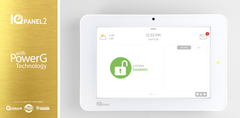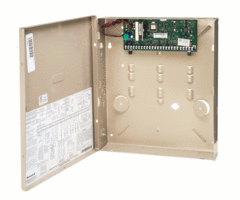Hi DIYers! Today, we're taking a look at SimpliSafe and how their monitoring service and equipment compares with Alarm Grid. We believe that this information will be helpful to end users when deciding upon an alarm monitoring provider. Let's see how SimpliSafe stacks up with Alarm Grid.

Proprietary Equipment
When a customer signs up for SimpliSafe, they are required to purchase a security panel and sensors directly from the company. This equipment is proprietary to SimpliSafe, and it will only work with their monitoring service. A user cannot take their SimpliSafe System and bring it to a different monitoring company. The equipment is for use with SimpliSafe only.
SimpliSafe does not require its customers to sign contracts. Their monitoring service is offered on a month-to-month basis. A customer can leave SimpliSafe at any time. The problem is that their system will be useless for alarm monitoring with any monitoring service outside of SimpliSafe. Unless a customer is willing to buy a completely new system, they will be stuck with SimpliSafe as their only option.
Alarm Grid does not manufacture its own equipment. Instead, Alarm Grid sells equipment from reputable manufacturers like Resideo/Honeywell, 2GIG, Qolsys and Interlogix. All the equipment sold on the Alarm Grid website is non-proprietary. If a customer decides to leave Alarm Grid, they can certainly bring their alarm panel, sensors and communicator with them to a new company.
Customers do not need to purchase their equipment from the Alarm Grid website. If they can find a better deal elsewhere, then we will encourage them to buy it from that location instead. Likewise, if a customer has an existing alarm system, we will do everything possible to take it over and make it work with our service. At Alarm Grid, we want to minimize the cost for our customers. Many systems and sensors can be taken over so that the customer does not need to buy new equipment.
Just like SimpliSafe, Alarm Grid is no contract, and customers pay on a month-to-month basis. The difference is that if a customer leaves Alarm Grid, they can take their system with them. Since the equipment we service is all non-proprietary, it can be taken over by any willing monitoring company. As a result, customers stick with Alarm Grid because they are pleased with the service and support we provide. This is the reason our customers refrain from taking their system and business elsewhere.
Equipment Compliance
Any reputable security equipment should be listed by a Nationally Recognized Testing Laboratory (NRTL). This is mandatory for meeting the requirements of National Electrical Code, NFPA 70 and UL Standards. For SimpliSafe, the proprietary wireless smoke detector and proprietary wireless carbon monoxide detector are both listed and labeled by the NRTL Intertek. This puts these devices in compliance with the aforementioned standards.
However, no other piece of SimpliSafe equipment is listed by Intertek. This includes the SimpliSafe Base Station (Panel) and the rest of the SimpliSafe Sensors. In fact, this equipment is not listed by any NRTL. In other words, this equipment is not necessarily compliant with UL Standards. It has not met the UL requirement of independent third-party testing needed for certified equipment. SimpliSafe says that they test their own equipment to UL standards, but this is different from the required third-party testing.
The equipment sold on the Alarm Grid website is UL or ETL listed and properly certified. It has met the third-party testing requirements. Additionally, the equipment we are familiar with taking over is also compliant with these standards. Again, companies like Resideo/Honeywell, 2GIG and Qolsys are known for their strict compliance. When you buy equipment from Alarm Grid you can be certain that you are getting quality equipment that is certified with the latest requirements.
Destruction Protection
Just like many systems, the SimpliSafe Base Station is designed to be placed out in the open for easy access. If an intruder destroys the base station before an alarm signal is sent out, then the signals might not go through successfully. To prevent this, SimpliSafe recommends disguising their system. One article claimed that a SimpliSafe representative suggested disguising their base station with a "lamp shade".
For Alarm Grid customers, their systems are connected with a reporting service like AlarmNet or Alarm.com. AlarmNet offers Advanced Protection Logic (APL), while Alarm.com provides "Crash & Smash". Although these features differ slightly, their general principle is the same. Both features are designed to ensure that the authorities are still properly dispatched if the security panel is destroyed.
The basic premise behind APL and Crash & Smash is that an alarm panel will immediately send an alert to the reporting service (AlarmNet or ADC) when an Entry Delay or communication delay period is activated. The reporting service will then know that either a system Disarm or an Alarm signal must logically follow. If after a certain period of time no signal is received, then the service will know that the panel must have been destroyed. In this case, APL or Crash & Smash will take effect, and the monitoring station will be notified.
Simply put, SimpliSafe does not offer this type of protection. Instead, the company advises its customers to hide and disguise its system. This can be very risky if an intruder recognizes the SimpliSafe Base Station and knows to destroy it. Additionally, the SimpliSafe Sensors do not include tamper covers. It's easily possible for a smart intruder to remove the cover for the sensor, take out the battery and beat the SimpliSafe System.
Life-Safety Offerings
Section NFPA 72 of the National Fire Alarm and Signaling Code requires that smoke detectors and CO detectors have the technical capability to produce distinct Temporal 3 and Temporal 4 sounding respectively. This is crucial for being able to actively distinguish between the type of danger at-hand and take the appropriate action.
SimpliSafe Smoke and CO Detectors do not have this functionality. As a result, they are non-compliant with NFPA 72. The only way for a SimpliSafe user to determine the cause of the alarm is to check the system's keypad or the associated text message from the SimpliSafe network. The SimpliSafe Base Station has an 85 dB sounder that meets code. However, this sounder is positioned downward. This positioning can muffle the siren and make it less likely for others to hear it.
SimpliSafe does offer an unsupervised external wireless siren that operates at 105 dB. However, this siren has no tamper switches and can be easily disabled by anyone who gains access. If the siren were to be taken offline, it is possible that the end user might not find out about this until it's too late.
Alarm Grid sells smokes and CO detectors with built-in sounders that meet the respective Temporal 3 and Temporal 4 sounder requirements. We also advise the use of supervised sirens that are either wired-in with the panel or protected by the system. Additionally, the wireless panels we sell feature built-in sounders that are positioned in such a manner that they can be easily heard when activated.
Conclusion
Whether you decide to go with SimpliSafe, Alarm Grid or a different monitoring company entirely is up to you. We can say that with Alarm Grid you can obtain a quality system that meets all the needed standards and requirements for your area. If you ever aren't satisfied with Alarm Grid for any reason, you can take the system you invested money into elsewhere and use it with a different monitoring company. You will also receive monitoring service that protects you and your family if your system is ever destroyed during a break-in.
We encourage you to check out our alarm monitoring page for more information about our monitoring services. If you decide that Alarm Grid is the right choice for your home, you can select a monitoring plan right from the same page. This page is also available through the orange "Alarm Monitoring" button at the top of any page on our website.
If you have any questions or you want to learn more about alarm monitoring, we invite you to reach out to us. The best way to reach us is to email support@alarmgrid.com. You can also call us at (888) 818-7728 during our normal business hours of 9am to 8pm EST M-F to speak with one of our security planners. Our team is here to help you make the right choice for home security monitoring, and we look forward to protecting you and your loved ones.


 Crash and Smash (C&S) for
Crash and Smash (C&S) for 







 Wiring sensors to a converter is actually very similar to wiring to a panel. The pictures of your old hardwired setup will be surprisingly helpful when connecting to a wired to wireless converter. You can check the pictures to see which wire goes to which terminal and even make sure the backup power supply is connected correctly. By placing the converter in the old location of the previous panel, all the sensors can remain in the same spot and easily connect with the converter(s).
Wiring sensors to a converter is actually very similar to wiring to a panel. The pictures of your old hardwired setup will be surprisingly helpful when connecting to a wired to wireless converter. You can check the pictures to see which wire goes to which terminal and even make sure the backup power supply is connected correctly. By placing the converter in the old location of the previous panel, all the sensors can remain in the same spot and easily connect with the converter(s).